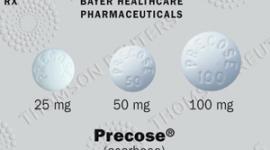Micronase, Glyburide, Diabetes Treatment - Micronase, Glyburide Patient Information
Brand names: Glynase, DiaBeta, Micronase
Generic name: Glyburide
Full Micronase prescribing information
What is Micronasse and why is Micronase prescribed?
Micronase is an oral antidiabetic medication used to treat type 2 diabetes, the kind that occurs when the body either does not make enough insulin or fails to use insulin properly. Insulin transfers sugar from the bloodstream to the body's cells, where it is then used for energy.
There are two forms of diabetes: type 1 and type 2. Type 1 diabetes results from a complete shutdown of normal insulin production and usually requires insulin injections for life, while type 2 diabetes can usually be treated by dietary changes, exercise, and/or oral antidiabetic medications such as Micronase. This medication controls diabetes by stimulating the pancreas to produce more insulin and by helping insulin to work better. Type 2 diabetics may need insulin injections, sometimes only temporarily during stressful periods such as illness, or on a long-term basis if an oral antidiabetic medication fails to control blood sugar.
Micronase can be used alone or along with a drug called metformin if diet plus either drug alone fails to control sugar levels.
Most important fact about Micronase
Always remember that Micronase is an aid to, not a substitute for, good diet and exercise. Failure to follow a sound diet and exercise plan can lead to serious complications, such as dangerously high or low blood sugar levels. Remember, too, that Micronase is not an oral form of insulin, and cannot be used in place of insulin.
How should you take Micronase?
In general, Micronase should be taken with breakfast or the first main meal of the day.
- If you miss a dose...
Take it as soon as you remember. If it is almost time for your next dose, skip the one you missed and go back to your regular schedule. Never take 2 doses at the same time. - Storage instructions...
Keep Micronase in the container it came in, tightly closed. Store it at room temper
continue story below
ature.
What side effects may occur?
Side effects cannot be anticipated. If any develop or change in intensity, inform your doctor as soon as possible. Only your doctor can determine if it is safe for you to continue taking Micronase.
Many side effects from Micronase are rare and seldom require discontinuation of the medication.
- More common side effects may include:
Bloating, heartburn, nausea - Less common or rare side effects may include:
Anemia and other blood disorders, blurred vision, changes in taste, headache, hives, itching, joint pain, liver problems, muscle pain, reddening of the skin, skin eruptions, skin rash, yellowing of the skin
Micronase, like all oral antidiabetics, may cause hypoglycemia (low blood sugar) especially in elderly, weak, and undernourished people, and those with kidney, liver, adrenal, or pituitary gland problems. The risk of hypoglycemia can be increased by missed meals, alcohol, other medications, fever, trauma, infection, surgery, or excessive exercise. To avoid hypoglycemia, you should closely follow the dietary and exercise plan suggested by your physician.
- Symptoms of mild hypoglycemia may include:
Cold sweat, drowsiness, fast heartbeat, headache, nausea, nervousness - Symptoms of more severe hypoglycemia may include:
Coma, pale skin, seizures, shallow breathing
Eating sugar or a sugar-based product will often correct mild hypoglycemia.
Severe hypoglycemia should be considered a medical emergency, and prompt medical attention is essential.
Why should Micronase not be prescribed?
You should not take Micronase if you have had an allergic reaction to it or to similar drugs such as chlorpropamide or glipizide.
Micronase should not be taken if you are suffering from diabetic ketoacidosis (a life-threatening medical emergency caused by insufficient insulin and marked by excessive thirst, nausea, fatigue, pain below the breastbone, and fruity breath).
Special warnings about Micronase
It's possible that drugs such as Micronase may lead to more heart problems than diet treatment alone, or diet plus insulin. If you have a heart condition, you may want to discuss this with your doctor.
If you are taking Micronase, you should check your blood or urine periodically for abnormal sugar (glucose) levels.
It is important that you closely follow the diet and exercise plan recommended by your doctor.
The effectiveness of any oral antidiabetic, including Micronase, may decrease with time. This may occur either because of a diminished responsiveness to the medication or a worsening of the diabetes.
Possible food and drug interactions when taking Micronase
If Micronase is taken with certain other drugs, the effects of either could be increased, decreased, or altered. It is especially important to check with your doctor before combining Micronase with the following:
- Airway-opening drugs such as albuterol
- Anabolic steroids such as testosterone and danazol
- Antacids
- Aspirin
- Beta blockers such as the blood pressure medications atenolol and propranolol
- Blood thinners such as warfarin
- Calcium channel blockers such as the blood pressure medications diltiazem and nifedipine
- Certain antibiotics such as ciprofloxacin
- Chloramphenicol
- Cimetidine
- Clofibrate
- Estrogens
- Fluconazole
- Furosemide
- Gemfibrozil
- Isoniazid
- Itraconazole
- Major tranquilizers such as trifluoperazine and thioridazine
- MAO inhibitors such as the antidepressants phenelzine and tranylcypromine
- Metformin
- Niacin
- Nonsteroidal anti-inflammatory drugs such as diclofenac, ibuprofen, and naproxen
- Oral contraceptives
- Phenytoin
- Probenecid
- Steroids such as prednisone
- Sulfa drugs such as sulfamethoxazole
- Thiazide diuretics such as the water pills chlorothiazide and hydrochlorothiazide
- Thyroid medications such as levothyroxine
- Be careful about drinking alcohol, since excessive alcohol consumption can cause low blood sugar.
Special information if you are pregnant or breastfeeding
The effects of Micronase during pregnancy have not been adequately studied in humans. This drug should be used during pregnancy only if the benefit outweighs the potential risk to the unborn baby. Since studies suggest the importance of maintaining normal blood sugar (glucose) levels during pregnancy, your physician may prescribe insulin injections during pregnancy.
While it is not known if Micronase appears in breast milk, other oral diabetes medications do. Therefore, women should discuss with their doctors whether to discontinue the medication or to stop breastfeeding. If the medication is discontinued, and if diet alone does not control glucose levels, then your doctor may consider insulin injections.
Recommended dosage for Micronase
Your doctor will tailor your dosage to your individual needs.
ADULTS
Usually the doctor will prescribe an initial daily dose of 2.5 to 5 milligrams. Maintenance therapy usually ranges from 1.25 to 20 milligrams daily. Daily doses greater than 20 milligrams are not recommended. In most cases, Micronase is taken once a day; however, people taking more than 10 milligrams a day may respond better to twice-a-day dosing.
CHILDREN
The safety and effectiveness of Micronase have not been established in children.
OLDER ADULTS
Older, malnourished or debilitated individuals, or those with impaired kidney and liver function, usually receive lower initial and maintenance doses to minimize the risk of low blood sugar (hypoglycemia).
Overdosage
An overdose of Micronase can cause low blood sugar (hypoglycemia).
- Symptoms of severe hypoglycemia include:
Coma, pale skin, seizure, shallow breathing
If you suspect a Micronase overdose, seek medical attention immediately.
last updated 02/2009
Full Micronase prescribing information
Detailed Info on Signs, Symptoms, Causes, Treatments of Diabetes
back to: Browse all Medications for Diabetes
APA Reference
Staff, H.
(2009, February 27). Micronase, Glyburide, Diabetes Treatment - Micronase, Glyburide Patient Information, HealthyPlace. Retrieved
on 2026, January 14 from https://www.healthyplace.com/diabetes/medications/micronase-glyburide-for-type-2-diabetes


